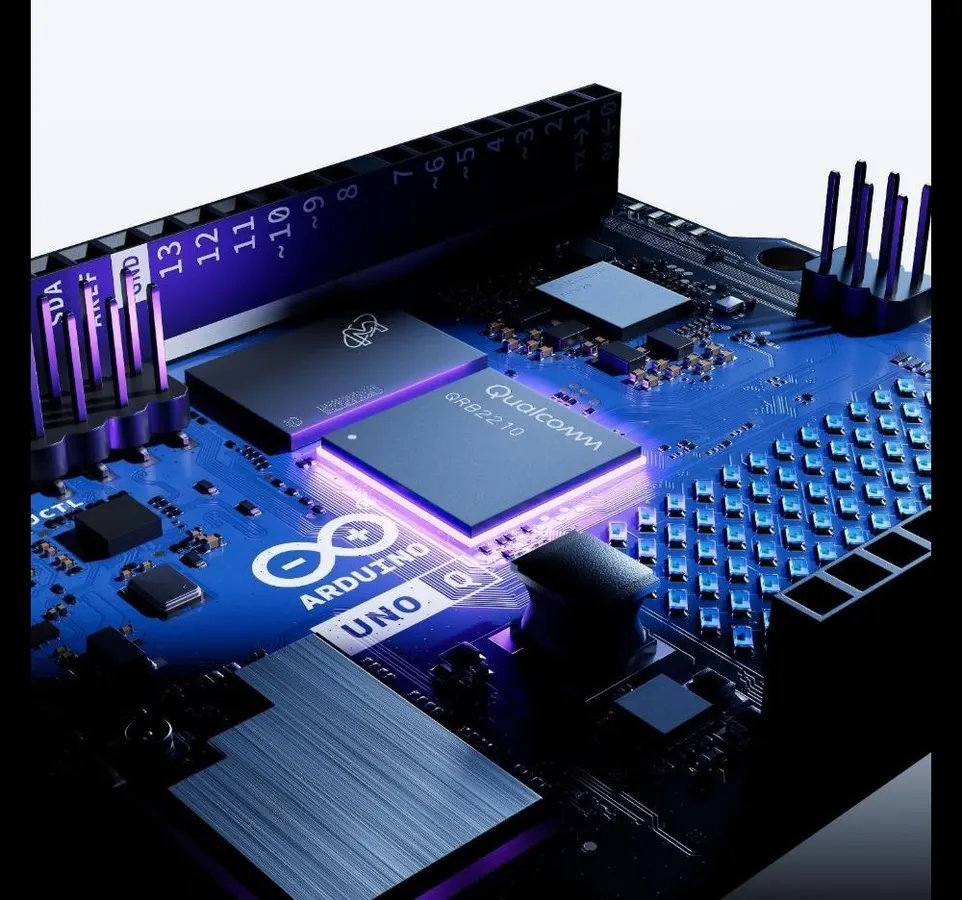Copyright forbes

Qualcomm-based Arduino UNO Q When Qualcomm recently announced its acquisition of Arduino, the technology press focused on specifications and development tools. But the real story is about market access. Qualcomm, a company built on selling chips to companies like Samsung and Apple in volumes of hundreds of millions, bought a platform whose users often purchase single development boards for hobby projects. The acquisition is an acknowledgement that the rules for winning IoT and robotics markets fundamentally differ from the enterprise playbook that built Qualcomm's $35 billion semiconductor business. The Developer Influence Problem Silicon vendors face a paradox in emerging hardware markets. Production contracts are decided years before manufacturing begins, during the prototyping phase when engineers select development platforms and establish technical preferences. This is at odds with Qualcomm's traditional approach to enterprise sales, which is rightly optimized for negotiating with procurement departments at established manufacturers, and has no mechanism for engaging the individual developers, university researchers, and startup engineers who make these early platform choices. MORE FOR YOU Nakul Duggal, Qualcomm's Group General Manager for Automotive, Industrial and Embedded IoT, described the problem to analysts directly: "To date, it's been difficult for smaller developers to get access to Qualcomm chips because they typically get sold in large quantities to established enterprises." This access barrier excludes Qualcomm from the experimentation phase, where robotics companies, industrial IoT developers, and edge AI startups establish the technical foundations that later become production requirements. A Pathway to Developers Arduino solves this access problem with its brute scale. The platform recorded nearly 40 million IDE downloads over the past year. These developers are learning hardware development, building robotics prototypes, and proving IoT concepts with low-cost Arduino boards. When their projects mature toward production, the technical architecture, processor preferences, and development expertise they established during prototyping heavily influence production silicon selection. Qualcomm has been absent from these formative decisions, ceding developer mindshare to competitors while its enterprise sales team focused on automotive OEMs and industrial equipment manufacturers. The timing matters because Qualcomm is aggressively ramping its IoT revenue growth. The company's IoT and automotive businesses combined account for 30% of chip sales revenue in the past quarter, up from negligible contributions a decade ago but still secondary to mobile. But IoT markets, particularly robotics and edge AI, feature fragmented ecosystems of startups and small manufacturers where enterprise sales approaches fail. Arduino provides access to this ecosystem without requiring Qualcomm to rebuild its go-to-market infrastructure from scratch. Building the Dragonwing Ecosystem Qualcomm launched its Dragonwing brand earlier this year to distinguish IoT and edge products from Snapdragon mobile processors. It’s an approach driven by the reality that the embedded and IoT market requires purpose-built silicon rather than repurposed smartphone chips. But new chip brands face a chicken-and-egg problem: developers won't invest time learning unfamiliar architectures without established ecosystems, and ecosystems don't form without developer adoption. The Arduino acquisition short-circuits this process by giving 33 million developers immediate access to Dragonwing. It also strongly positions Dragonwing as an accessible brand. The Arduino acquisition also completes a three-company strategy that began with Qualcomm's recent acquisitions of Edge Impulse and Foundries.io. Together, these acquisitions address the full IoT development lifecycle: Arduino provides accessible hardware prototyping, Edge Impulse's native integration with Arduino's new App Lab development environment allows developers to train AI models and deploy them to Dragonwing processors without navigating multiple vendor relationships. Foundries.io's secure OTA capabilities extend to Arduino-based prototypes, maintaining continuity in device management from prototype through production. These integrations reduce friction at each development stage while consistently exposing developers to Qualcomm technologies and building familiarity that influences eventual production decisions. New Dragonwing-based Arduino As part of its acquisition announcement, Arduino introduced its new Arduino UNO Q board. The new development board, priced at $44-59, features Qualcomm's Dragonwing QRB2210 processor alongside an STM32U5 microcontroller in a dual-processor architecture. This makes the QRB2210 the most accessible Qualcomm chip available, eliminating minimum order quantities and enterprise sales requirements that have historically blocked individual developers and startups from prototyping with Qualcomm silicon. Converting Customers One of Qualcomm’s biggest challenges is converting Arduino users to commercial customers. This requires either building new sales capabilities appropriate for small manufacturers or partnering with distributors and design services that bridge this gap. The acquisition provides developer access but doesn't automatically solve the go-to-market challenge for serving these developers when they're ready to purchase production silicon. This execution gap matters because Qualcomm's automotive success doesn't provide a relevant model. Automotive customers are established manufacturers with procurement departments and enterprise sales processes that Qualcomm's organization serves effectively. IoT startups developing robotics or edge AI products face unique constraints, including limited capital, urgent time-to-market pressures, and the need for flexible volume commitments that diverge from Qualcomm's traditional business model. Building the commercial infrastructure to convert Arduino prototyping into production revenue requires sustained organizational investment beyond the acquisition transaction. Balancing Arduino’s Silicon Neutrality There’s also a multi-vendor element that creates additional tensions. Arduino will continue supporting boards with chips from STMicroelectronics, Renesas, Microchip, and NXP, maintaining the platform neutrality that built its community trust. Qualcomm acquired Arduino specifically to promote Dragonwing silicon, creating inherent conflicts around resource allocation, product development priorities, and marketing focus. Community members and competing silicon vendors will scrutinize these decisions for bias. Any perception that Qualcomm prioritizes its own chips over ecosystem neutrality risks fragmenting the community that makes Arduino valuable. Qualcomm’s Diversification Imperative The Arduino acquisition ultimately reflects Qualcomm's urgency to diversify revenue beyond mobile. While the company's automotive business has grown substantially, delivering $984 million in revenue during Qualcomm’s latest fiscal quarter, it suffers from longer design cycles and lower unit volumes compared to smartphones. IoT markets offer higher unit volumes across more diverse applications, but success requires fundamentally different market engagement than Qualcomm has historically employed. This is where Arduino comes into the picture. Arduino serves as Qualcomm's conduit to an audience of nearly 33 million IoT developers. It’s a powerful play, but one that will take patience to pay off as Qualcomm builds out its Dragonwing brand and learns from Arduino. The Path Forward The burden for Qualcomm is to prove it can operate two parallel business models: traditional enterprise sales for automotive and established IoT manufacturers, and community-oriented developer engagement for Arduino and emerging robotics companies. Despite execution challenges and extended timelines, Qualcomm has assembled the right assets for IoT market leadership at a moment when robotics and edge AI markets are transitioning from experimentation to commercialization. Qualcomm’s technical capabilities in AI acceleration, power efficiency, and connectivity were never in question. What Qualcomm lacked was market access and developer relationships in fragmented, startup-driven markets where traditional enterprise sales fail. The Arduino, Edge Impulse, and Foundries.io acquisitions directly address these gaps, providing a complete development-to-deployment platform that no competing silicon vendor can match through partnerships alone. The Dragonwing brand now enters the market with 33 million developers already familiar with its development platform, immediate presence in educational institutions shaping the next generation of hardware engineers, and a credible prototype-to-production story spanning AI development, hardware prototyping, and device management. The Arduino acquisition won't solve Qualcomm's near-term diversification challenges. Still, it positions the company to capture leadership in robotics and edge AI markets as they scale from startups and research labs into mainstream industrial adoption over the next decade. Qualcomm’s recent IoT-focused acquisitions, coupled with its Dragonwing momentum, show the company placing powerful bets. It’s well timed, as AI begins extending to the edge and manifests in robotics and other physical forms. It’s also reminiscent of the foundational bets Qualcomm placed at the beginning of the mobile revolution that ultimately built a $37 billion giant. Disclosure: Steve McDowell is an industry analyst, and NAND Research is an industry analyst firm, that engages in, or has engaged in, research, analysis and advisory services with many technology companies, including those mentioned in this article. No company mentioned was involved in the writing of this article. Editorial StandardsReprints & Permissions



